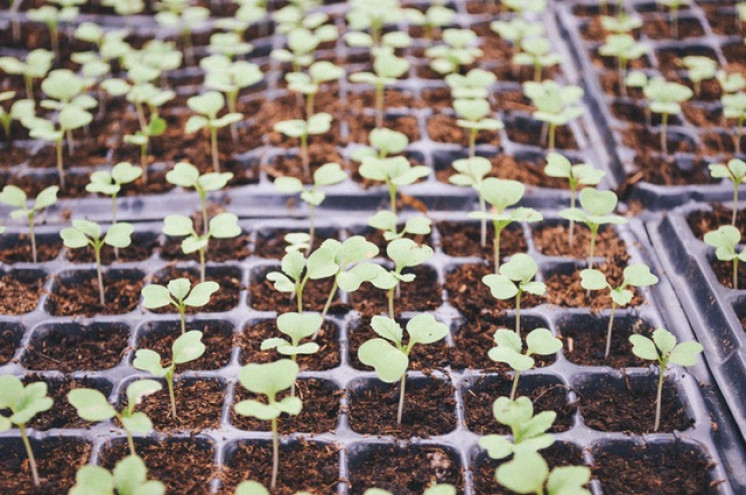
In spite of the temperature swing back to wintertime after a few weeks of spring, it’s still the moment to start thinking about gardening. Our calendar is filling with gardening classes and workshops, and the Vermont Flower Show is this weekend. Vermont farmers will be planting seeds indoors not just for their own crops, but to sell as starts in the first Farmers’ Markets of spring. Some of us got into the spirit of gardening for 2017 a few weeks ago in the homesteader track of the NOFA-VT conference. Charlie Nardozzi is an author, speaker, commentator and workshop leader who has been educating us about gardening for years - and to encourage garden dreaming we’re bringing you excerpts from his most recent newsletter. You can read the full newsletter and see where Charlie is speaking next at his website: http://gardeningwithcharlie.com/
Climatologists have been predicting wild swings in the weather with global warming, but the last week or so here has been downright amazing. From blizzard conditions to 70F and flooding, back to freezing temperatures. Not only am I confused, my plants probably are too. Luckily, it didn’t stay warm for long so the return to colder weather shouldn’t cause too much damage.
With all this exciting weather, it’s hard to stay focused on what needs to be done in the garden. In many locations vegetable seed starting indoors is happening now. Vegetables need to be started at the right time for the type of vegetable and your location. The first step is to figure out your last frost date. Then work backwards. Quick growing seeds such as lettuce, Swiss chard and arugula can be started 4 weeks before the last frost date and transplanted a week or so before that date into the ground. Other cool season crops, such as cabbage and broccoli, need 6 to 8 weeks of indoor growing. Warm season crops need more time as well. Tomatoes and basil need 4 to 6 weeks while peppers and eggplant 6 to 8 weeks. Watch my video from when I was with the National Gardening Association for tips on vegetable seed starting. . . .
One crop you’ll be starting indoors soon is peppers. There is a trend in pepper breeding towards smaller sized fruits and plants. The latest group that I’ve noticed getting petite are sweet peppers. These baby bells and baby frying peppers are only 3 to 4 inches long. But plant breeders wouldn’t be going to all this work if the public wasn’t wanting it. The advantage of the smaller peppers is you get more fruits, ripening to their mature color sooner. Plus, breeders haven’t forgotten about flavor, so these smaller varieties are just as sweet as the full size ones. These smaller varieties have smaller plants as well so are perfect for containers and small raised beds.
If you want to foray into the land of baby peppers, try the ‘Baby Belle’ Mix. This variety features 3-inch long bell peppers in red and yellow. The seed in the packet is color coded so you can plant as many red or yellow plants as you like. These sweet babies are great raw right off the plant, grilled or sauteed. ‘Pizza My Heart’ is a Christmas tree shaped 2-foot tall plant with red cone-shaped fruits. It’s perfect for container growing. Of course, the small fruit revolution is not restricted to bell peppers. ‘Yummy Bells’ is an Italian frying pepper that turns orange at maturity but only grows 4 inches long. The ‘Orange’, ‘Red’ or ‘Yellow’ Picnic peppers are also short and sweet. You can buy these varieties in a mix in one packet as the Picnic Pepper Collection. Learn more about growing peppers here. . .
A favorite, low maintenance perennial and annual flower that’s an early bloomer in our garden is Centurea. This spring blooming flower goes by many names such as cornflower, mountain bluette, and bachelors buttons. Whatever you call it, it’s a familiar friend in the garden. This 2 to 3 foot tall perennial produces spider-like flowers that repeat bloom. The traditional color for cornflowers is blue, but there are now many color variations. ‘Amethyst in Snow’ is one of my favorites. It has white, tube-shaped flower petals radiating out from a deep purple center. The plant is more compact than other perennial cornflowers. ‘Amethyst Dreams’ has solid purple colored flowers. You can also buy wildflower cornflowers that are annuals, but will self sow. These mixes have blue, white and red colored cornflowers blended together.
Plant your perennial cornflowers in spring in full sun pairing them with other spring bloomers such as nepeta, geranium and iris. I like to plant them in groups so they support each other and don’t flop over after a storm. The flowers are a bee and butterfly magnets so they make nice pollinator garden flowers as well. After flowering is finished, cut back the plant by 2/3rds and it will regrow and flower again in late summer. Like the annual types of cornflowers, the perennials also self sow readily, so be ready to be thinning and moving seedlings each spring. For more details on growing cornflowers, go here.
Want flowers sooner? Check out this information on forcing flowering branches. Or, even sooner, there is the Vermont Flower Show, March 3rd - 5th - a great way to get a dose of the sights and smells of spring.
Some other ideas on what you can do right now for a gardening fix from the Vermont Garden Journal: 6 Tips for Starting a Windowsill Herb Garden; Giving Your Produce Scraps a Second Life; Design Tips from an English Cottage Garden; Planning Your Shade Garden
Ready to get gardening? Read more from Charlie at http://gardeningwithcharlie.com/













